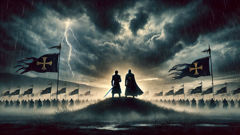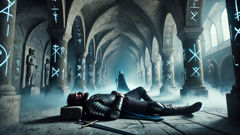Introduction
At the edge of Denmark’s northern coast, where the Kattegat meets the Øresund, Kronborg Castle rises in stony majesty above the churning sea. Its spires pierce the sky, battered by centuries of wind and salt, standing watch over the strait like a silent sentinel. Beneath its labyrinthine halls and echoing corridors, a secret legend takes root—a tale woven into the very stones and whispered across generations. This is the story of Holger Danske, or Ogier the Dane, a name that carries the weight of Danish hope, courage, and unity.
Holger Danske is no mere figure from a dusty chronicle. To Danes, he is the living promise that in Denmark’s hour of greatest peril, a hero will rise from his enchanted sleep and defend the realm. They say he slumbers deep within the fortress cellars of Kronborg, his bearded face resting on stone, his mighty arms cradling a sword forged in myth. Some claim his heart still beats with the pulse of the nation, attuned to every tremor of danger that stirs above. His legend is carved into wood, painted on walls, and recited by candlelight—a story that binds past to present, myth to memory.
But Holger Danske’s origins stretch far beyond the castle’s shadow. He began as a mortal knight—a prince and a warrior whose deeds traversed kingdoms, whose loyalty shaped destinies. Across medieval battlefields and court intrigues, through moments of loss and triumph, Holger’s journey forged the legend he would become. His tale is one of valor and sacrifice, of a man transformed by love for country and kin, whose spirit was claimed not by death but by the promise of return.
To step into Holger’s story is to walk among the mists of Danish history, where the boundaries between truth and legend blur like fog over the Øresund. Here, faith and folklore entwine: an enchanted knight, a sleeping guardian, a nation forever awaiting the sound of his awakening. The legend of Holger Danske is Denmark’s dream of itself—unyielding, steadfast, ever watchful—waiting in silence, ready to rise.
The Making of a Knight: Ogier’s Early Years
In the days when Denmark was a patchwork of kingdoms and the world was ruled by sword and oath, Ogier was born the son of King Godfred. From the beginning, his fate was tangled with the destinies of his people. Even as a child, he was drawn to the clang of steel and the discipline of the training yard, his eyes keen with the promise of greatness. The old masters who watched him saw in Ogier a rare mixture—compassion woven with courage, and a mind as quick as his blade.

Ogier’s childhood was not gilded with comfort. The Danish court was a place of shifting alliances and ceaseless intrigue, where danger often hid behind smiles. His mother, Queen Ingrid, instilled in him the values of mercy and wisdom, whispering stories of the ancient gods and the duty owed to land and kin. But it was his father’s world—the world of battle—that shaped him most. At twelve, Ogier was already taller than most grown men, and at fifteen, he rode out to war alongside his father’s retainers, defending Denmark’s borders against Frankish incursions.
In those years, Ogier’s legend began to take shape. He earned his first scars at the Battle of Hedeby, where he turned the tide against a horde of raiders by rallying his men with a ferocity that belied his youth. When a Frankish champion challenged the Danish host to single combat, it was Ogier who stepped forward, sword gleaming in the morning light. The duel was short and brutal; with each blow, Ogier’s name grew among the warriors who witnessed his skill. Tales of the young prince spread swiftly through the mead halls and villages—of his unyielding resolve and his kindness to those vanquished.
Yet, even in victory, Ogier was haunted by dreams. He would wake in the deep hours of night, visions of a burning castle and the roar of foreign armies churning in his mind. He confided these dreams only to his mother, who saw in them the seeds of prophecy. “The land calls to you,” she would say, pressing her hand to his brow. “You are not meant for ordinary days, my son.”
As Ogier reached manhood, Denmark entered an uneasy peace. The court at Jelling buzzed with news from beyond its borders—Charlemagne’s star was rising in the south, and with it, the specter of conquest. Envoys came and went, bearing gifts and veiled threats. Ogier, restless in peacetime, found solace in the forests and by the shores, riding alone and listening to the wind in the birches. It was here, among the ancient trees, that he first met Morgaine, a healer’s daughter whose laughter seemed to chase away his shadows. Their bond grew quietly, a single bright thread in the tapestry of his destiny.
But fate is rarely gentle. When treachery struck at the heart of the Danish court—a cousin seeking the throne, a poisoned cup meant for the king—Ogier found himself thrust into turmoil. His father’s death was swift, his mother’s exile cruel, and Denmark’s fate suddenly hung by a thread. With the weight of the crown pressing upon him, Ogier had to choose between vengeance and justice, personal longing and the greater good. It was in these trials that his character was forged, tempered by sorrow as much as by steel.
As he donned his father’s sword and took the oath of kingship, Ogier pledged himself not only to Denmark but to the ideal of a protector—one who would stand against darkness, no matter the cost. The seeds of his future legend were sown in those turbulent years: a warrior shaped by loss, a heart steeled by love and loyalty, a man destined to become more than flesh and bone.
Trials of Valor: The Hero’s Journey Beyond Denmark
Ogier’s ascension to the Danish throne was not met with quiet acceptance. Nobles bristled at his youth, whispering doubts in shadowed corners. Yet with each passing moon, Ogier proved his mettle—not only on the battlefield but in council chambers, where wisdom often counted for more than strength. His reforms brought relief to peasants long burdened by war, and his insistence on fairness quelled much unrest. Still, destiny would not allow him to rest.

Word came from Frankish lands that Charlemagne sought allies—or subjects. When envoys arrived bearing banners marked with the imperial eagle, Ogier welcomed them with courtesy but remained wary. Negotiations teetered between diplomacy and threat, and soon enough, Charlemagne’s ambitions became clear. Denmark would bend the knee, or face the full might of the Frankish armies.
When battle became inevitable, Ogier led his warriors south. The march was grueling: through rain-swept moors and tangled forests, across rivers swollen with spring melt. His men followed him not out of fear, but trust—a bond forged through hardship and shared resolve. On the banks of the Elbe, Danish and Frankish forces clashed in a storm of steel and fury. Ogier’s command was resolute; he led from the front, sword flashing, armor splattered with mud and blood. Each victory was hard-won, each loss mourned as kin.
Yet even as he battled for Denmark’s freedom, Ogier’s fate twisted further. In a moment of betrayal, he was captured by Charlemagne’s knights and taken to Aachen—a prisoner in the court of his enemy. The days in captivity tested him in ways the battlefield never could. Ogier was paraded before nobles, mocked as a vanquished king, yet he bore every humiliation with a dignity that unsettled his captors. In these lonely months, he found an unlikely friend in Roland, Charlemagne’s famed paladin, whose sense of honor matched Ogier’s own. Through whispered conversations and secret chess games, a kinship grew—one that would eventually turn the tides of legend.
Charlemagne, impressed by Ogier’s unbreakable spirit, offered him a place among the paladins. Torn between loyalty to Denmark and a growing respect for his captor’s code, Ogier accepted—on the condition that Denmark’s sovereignty would be honored. Thus began a new chapter: Ogier the exile, fighting not against his enemies but beside them, forging alliances that spanned borders and beliefs. Together with Roland and the other knights, he faced threats that dwarfed mortal ambition—sorcerers from the east, monstrous beasts from shadowy woods, and conspiracies that threatened the very fabric of Christendom.
One of the most fabled episodes came during the campaign against Agramant, the Moorish king whose armies swept through southern Europe. The paladins were outnumbered and beset on all sides. In the desperate siege of Narbonne, Ogier’s courage became legend. He led a midnight raid that broke the enemy’s lines, freeing besieged villagers and turning the tide of battle. Bards would later sing of how Ogier’s sword glowed with an unearthly light, how he seemed to stride unharmed through fire and arrowstorm.
Amidst glory and peril, Ogier never forgot his homeland. Letters carried by trusted hands found their way back to Morgaine and the Danish court, assuring them of his survival and his undimmed purpose. But each triumph was shadowed by longing. He yearned for the wind over the Kattegat, for the laughter of friends, for the peace of forests untouched by war. His time among the paladins brought honor and wisdom, but also a growing sense that his true destiny lay beyond mortal battles—a destiny waiting patiently, like a sword in its scabbard, to be revealed in time.
The Gift and the Curse: Enchantment at Kronborg
Years passed. Ogier’s reputation grew until he was spoken of in the same breath as Roland and Charlemagne himself. Yet even as victories piled behind him, so too did burdens. The world was changing—old gods fading, new faiths rising, and the borders of kingdoms redrawn by war. Ogier was weary. The taste of glory had dulled, replaced by longing for home and the ache of all he had lost.

It was on his return journey to Denmark that the shape of his legend shifted from history into myth. Sailing northward, his ship was caught in a supernatural storm off Helsingør. Winds shrieked with voices not quite human, and thunder shattered the sky with spectral fire. The crew fought to keep the vessel afloat as a ghostly fog enveloped them. Amidst this chaos, Ogier saw a vision—a woman robed in moonlight, her hair woven with seaweed, standing atop the waves. She called his name, her voice threading through the storm: “Ogier, son of Denmark, your time as a mortal knight wanes. Will you bear a new burden, one that will outlast flesh and memory?”
Ogier did not shrink from destiny. He asked what price such a gift demanded. The woman—revealed as Morgan le Fay, the ancient enchantress—spoke of a slumber that was not death, a watchful sleep beneath the stones of Denmark’s most hallowed castle. “In times of darkness,” she said, “your country will need a guardian not bound by mortal chains. Will you rest beneath Kronborg’s foundations, waiting to defend your homeland until the end of days?”
The offer was both blessing and curse. Ogier thought of Morgaine, of friends lost in distant wars, of the quiet fields of Denmark. To accept would mean surrendering all hope of ordinary life—but it would also mean becoming Denmark’s eternal shield. With a heavy heart, Ogier agreed. Morgan le Fay touched his brow, and a wave of drowsiness swept over him. The ship sailed safely into Helsingør, its crew none the wiser; only Ogier remembered the pact as he stepped ashore.
At Kronborg Castle, Ogier was greeted as a hero returned. Yet he walked its halls like a man in a dream, already half-claimed by enchantment. He met Morgaine one last time beneath the castle’s oldest tower. “This is not farewell,” he whispered, “but a promise—that when Denmark needs me most, I will return.” They parted with tears and hope tangled together.
That night, beneath the deepest cellars of Kronborg, Ogier lay down on a stone bench. Morgan le Fay’s magic wove around him like fog; his sword rested across his knees, his beard curling over breastplate and shield. He closed his eyes to the world he had known—not to die, but to sleep, as only heroes chosen by destiny can sleep. In his dreams, he watched Denmark through centuries: cities rising and falling, wars won and lost, generations born and gone. Yet he remained unchanged, the silent guardian beneath Kronborg’s stones.
Conclusion
Centuries have passed since Ogier—now Holger Danske—laid down his sword beneath Kronborg. In times of peril, when foreign armies threatened Denmark’s shores or when the spirit of the nation seemed tested by doubt, rumors would swirl that he had stirred beneath the castle stones. Some claimed to have heard footsteps echoing in empty corridors; others swore that the stone statue in Kronborg’s cellar breathed in the gloom. In every generation, Holger’s promise endured: that Denmark would never be without hope so long as one true heart stood ready to defend her.
Today, Holger Danske’s legend is more than a story—it’s a living part of Danish identity. His image watches over soldiers, schoolchildren, and statesmen alike. Carved in stone and sung in verse, he is both comfort and challenge: a reminder that courage is not measured by victory alone, but by the willingness to rise when called upon. The tale of Holger Danske bridges history and dream, inviting each new listener to believe in the power of heroes and in the unbreakable bond between land and people.
As long as Kronborg stands against wind and tide, and as long as the Danish spirit endures, Holger Danske will sleep beneath its stones—waiting for the hour when Denmark once again calls its guardian home.













